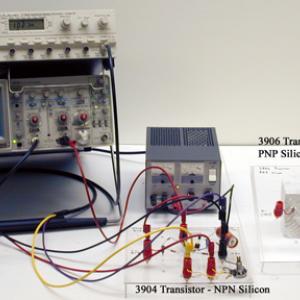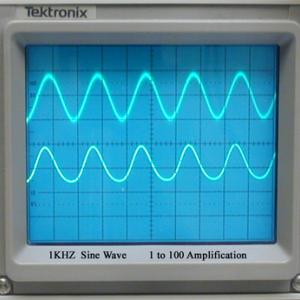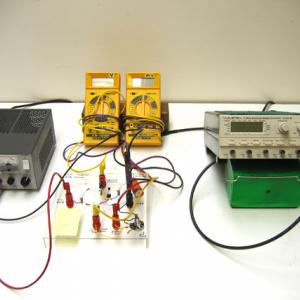College of Liberal Arts & Sciences
5M10.65 - Transistors
NOTE: All the ground leads from the wave generator, power supply, and oscilloscope (both channels), must be connected to the ground post of the demo unit.
Plug the wave generator into the signal input post, channel 1 of the oscilloscope into the signal reference post and channel 2 of the oscilloscope into the output post. Plug the power supply into the voltage post. Care must be taken to be sure that you have the right voltage input. For instance, the 3906 transistor is a PNP device and needs a -12 volts to the voltage post, and the 3904 transistor is a NPN device and needs a +12 volts. This information is written on the demo units. Both the 3904 and the 3906 will give about a 1 to 100 amplification. The variable pots that are mounted on the boards are just to attenuate the signal input so that the transistors are not overdriven.
The oscilloscope may be replaced with volt meters. A voltmeter on the input side can be set at millivolts, and the one on the output side can be set at volts. Set the frequency of the signal generator to 1000 Hz. As you turn the pot on the input side you can monitor the amplification through the transistor.
- Faith Onder, Esra Bilal Onder, Mehmet Ogur, "Determining Transistor Characteristics With Arduino", TPT, Vol. 58, #6, Sept. 2020, p. 422.
- Victor E. Henrich, "Gravitational Model of a p-n Junction", TPT, Vol. 56, #8, Nov. 2018, p. 538.
- Giovanni Organtini, "A Flush Toilet Model for the Transistor", TPT, Vol. 50, #4, Apr. 2012, p. 221.
- Fred Inman, "A Simple Laboratory Experiment to Measure e/k", TPT, Vol. 43, # 1, Jan. 2005, p. 27 - 28.
- Stephen Luzader and Eduardo Sanchez-Velasco, "Transistor Effect in Improperly Connected Transistors", TPT, Vol. 34, #2, Feb. 1996, p. 118.
- Samuel Derman and Wallace T. Anderson, "Semiconductor Reliability - Another Field for Physicists", TPT, Vol. 32, #4, Apr. 1994, p. 226.
- Richard W. Henry, "Superconducting Microelectronics", TPT, Vol. 22, #2, Feb. 1984, p. 74.
- J. Matolyak, R. Roberts, and R. Berry, "Nonlinear Circuit Concepts - An Elementary Experiment", TPT, Vol. 21, #8, Nov. 1983, p. 522.
- David L. Mott, "A Simple Transistor Demonstration", TPT, Vol. 18, # 6, Sept. 1980, p. 460.
- Zenon Gubanski, "Transistor Characteristic Curves on an Oscilloscope", TPT, Vol. 11, #6, Sept. 1973, p. 359.
- Donald Long, "Electrical Conduction in Solid", TPT, Vol. 7, #5, May 1969, p. 264.
- Walter H. Brattain, "Genesis of the Transistor", TPT Vol. 6, #3, Mar. 1968, p. 109.
- R. E. Alley, "Experiments with Semiconductor Devices", TPT, Vol. 3, # 5, May 1965, p. 199.
- R. E. Alley, "Semiconductors and Semiconductor Devices", TPT, Vol. 3, #2, Feb. 1965, p. 55.
- Pierre de Buyl, "A Digital Oscilloscope Setup for the Measurement of a Transistor's Characteristic Curves", AJP, Vol. 78, #12, Dec. 2010, p. 1425.
- M. D. Sturge and Song Bac Toh, "An Experiment to Demonstrate the Canonical Distribution", AJP, Vol. 67, #12, Dec. 1999, p. 1129.
- Charles W. Fisher, "Elementary Technique to Measure the Energy Band Gap and Diffusion Potential of pn Junctions", AJP, Vol. 50, #12, Dec. 1982, p. 1103.
- Ashley G. Smart, "Polymer-based transistors bring fully stretchable devices within reach", Physics Today, Vol. 70, #3, Mar. 2017, p. 14.
- "Wearable Transistor Can Heal Its Own Wounds", Physics Today, Vol. 70, #1, Jan. 2017, p. 22.
- Jeremey N. A. Matthews, "Semiconductor Industry Switches to Hafnium-Based Transistors", Physics Today, Vol. 61, #2, Feb. 2008, p. 25.
- Ian M. Ross, "The Foundation of the Silicon Age", Physics Today, Vol. 50, #12, Dec.1997, p. 34.
- Michael Riordon and Lillian Hodderson, "The Moses of Silicon Valley", Physics Today, Vol. 50, #12, Dec.1997, p. 42.
- Jonathan Hare, "How to Demonstrate the Wonderful", Physics Education, March 2004, p. 128.
- Earl R. Feltyberger et al., "Bipolar Junction Transistor Switches", Teaching About D. C. Electric Circuits, p. 3.19.
- Earl R. Feltyberger et al., "Transistors as Switches", Teaching About D. C. Electric Circuits, p. 2.8.
- Jearl Walker, "5.45, Electric-Guitar Amplifiers", The Flying Circus of Physics Ed. 2, p. 238.
- Yaakov Kraftmakher, "6.7, Transistor", Experiments and Demonstrations in Physics, ISBN 981-256-602-3, p. 419.
- Dave Blackman, "Transistor Circuitry", PIRA Newsletter, Vol. 3, # 7, November 18, 1988, p. 4.
- Dave Blackman, "Transistors", PIRA Newsletter, Vol. 3, # 5, September 10, 1988, p. 5.
- Mannie Horowitz, "Bipolar Junction Transistors", Elementary Electricity and Electronics - Component by Component, p. 211 - 251.
- "Transistor Characteristics", Selective Experiments in Physics, CENCO, 1962.
- "Principles of Vacuum Tubes", Selective Experiments in Physics, CENCO, 1944.
- Keithley Instruments, "Electrical Engineering Experiment # 5: Transistor Amplifiers", Series I.
Disclaimer: These demonstrations are provided only for illustrative use by persons affiliated with The University of Iowa and only under the direction of a trained instructor or physicist. The University of Iowa is not responsible for demonstrations performed by those using their own equipment or who choose to use this reference material for their own purpose. The demonstrations included here are within the public domain and can be found in materials contained in libraries, bookstores, and through electronic sources. Performing all or any portion of any of these demonstrations, with or without revisions not depicted here entails inherent risks. These risks include, without limitation, bodily injury (and possibly death), including risks to health that may be temporary or permanent and that may exacerbate a pre-existing medical condition; and property loss or damage. Anyone performing any part of these demonstrations, even with revisions, knowingly and voluntarily assumes all risks associated with them.


